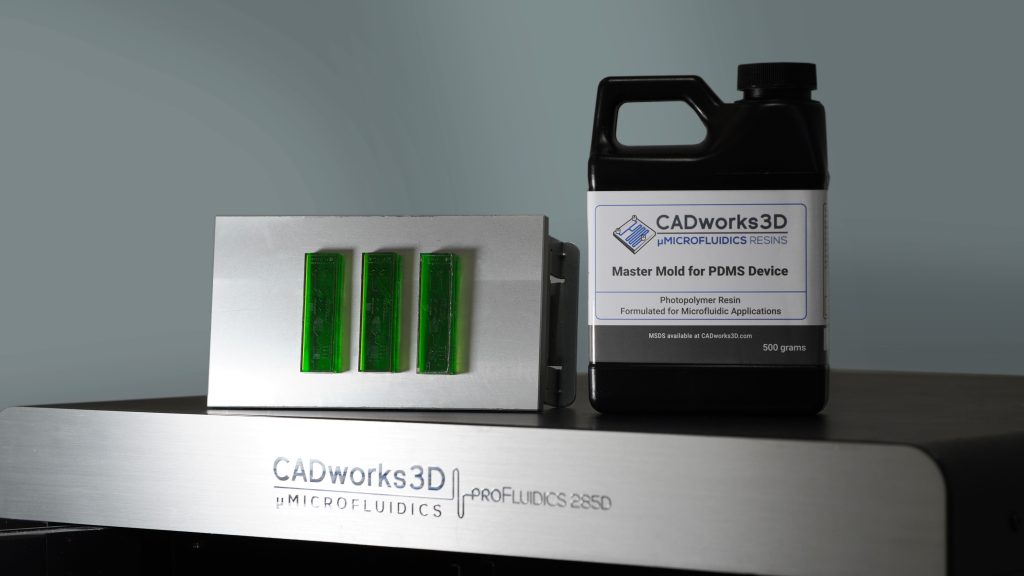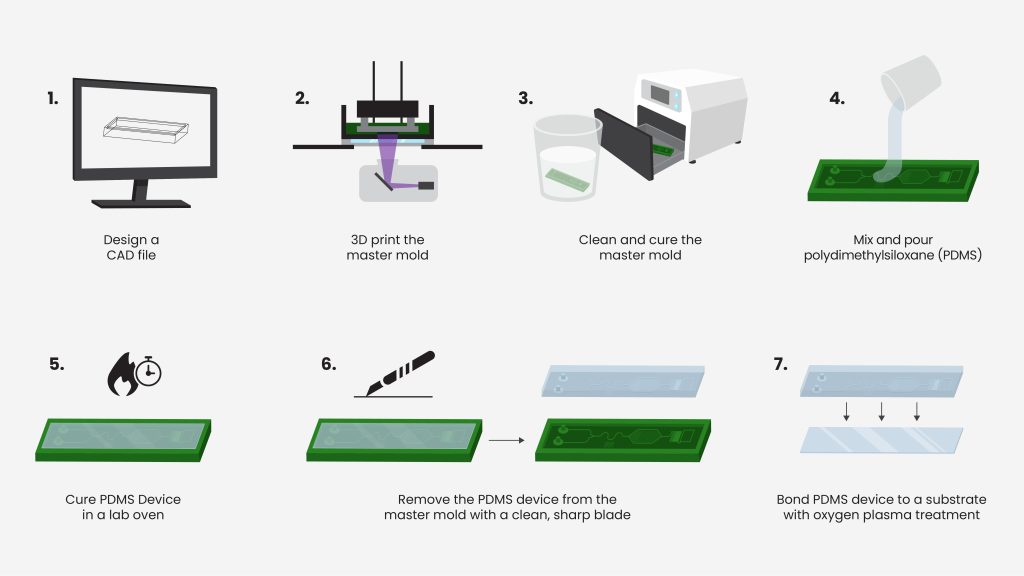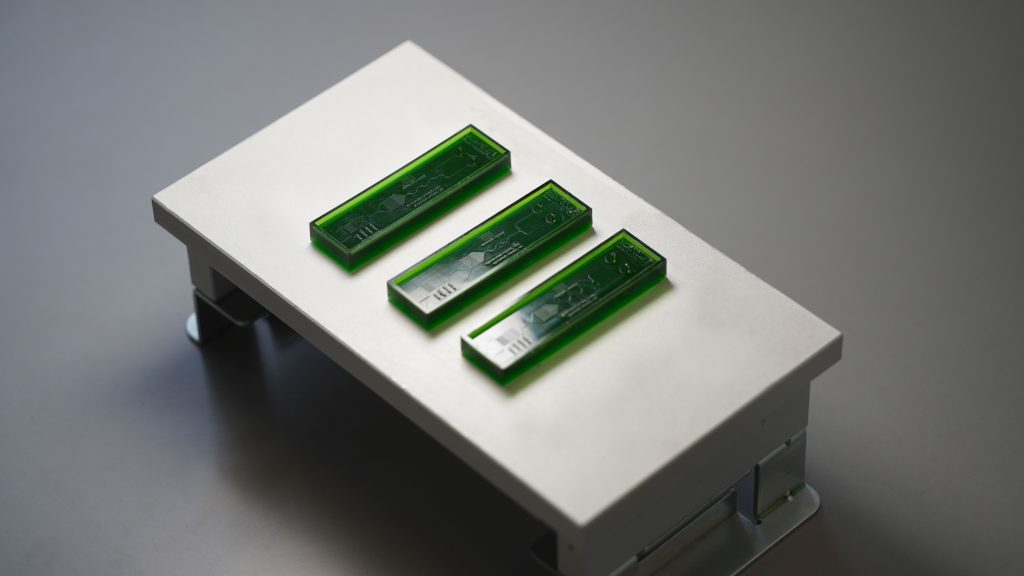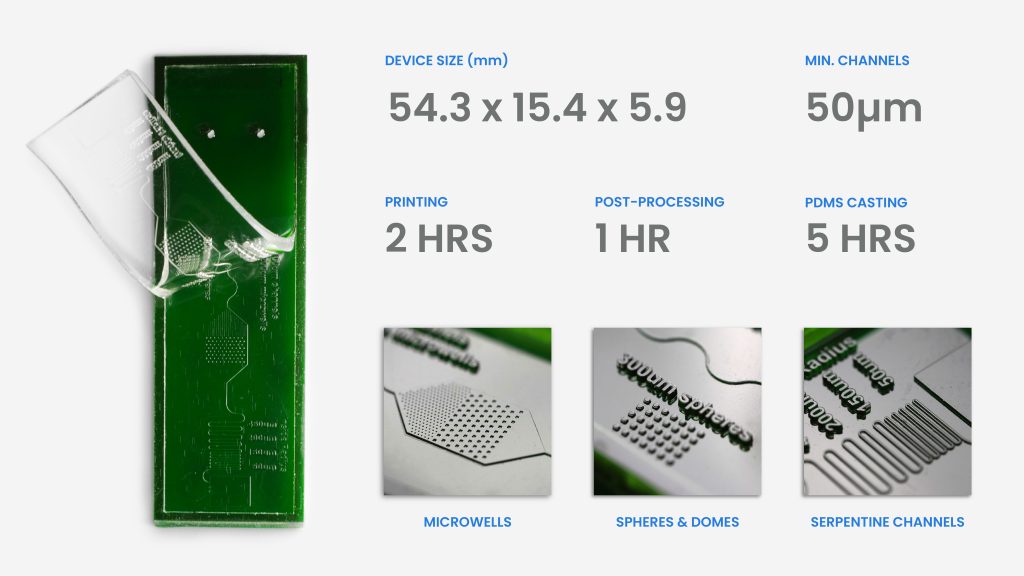In recent years, there have been significant advances in the fabrication of PDMS microfluidic devices. After moving from more traditional methods like photolithography to cost-effective alternatives such as soft lithography and now, new research exploring how 3D printing can be integrated into existing device fabrication workflows.
CADworks3D, a Canadian 3D printer maker and developer of 3D materials, is a market leader. CADworks3D combines groundbreaking 3D technology with specialized photopolymer 3D materials to create a complete 3D solution for fabricating PDMS device. This includes the ProFluidics285D DLP Printer and their photopolymer in-house resin, Master Mold for PDMS devices.

Soft Lithography is the evolution of Photolithography
Photolithography was the technique of choice for creating microstructures on microfluidics devices in the early stages of microfluidics research. Photomasks and cleanrooms were used along with complex chemical processes to create patterns on substrates such as silicon wafers or glasses slides.
Although photolithography allows for high-resolution patterns, there are some notable limitations. To make a single product, it takes many steps with several tools and chemical. This technique is expensive, and requires specialized equipment as well as cleanroom facilities. Photolithography does not produce complex structures or designs. Photolithography is a one-layer process. To create multilayer structures, or 3D microfluidics systems, multiple rounds of photolithography are required. These processes can be time-consuming and subject to alignment errors.
Photolithography works best with semiconductor materials such as silicon and glass. It is not suitable for materials incompatible to the harsh chemicals or high temperatures that are used during the process. In the years that followed, the need for microfluidics devices with greater versatility and accessibility has increased. Soft lithography emerged as the game changer in this industry.
Soft Lithography for PDMS Devices
Soft lithography was developed as an alternative to photolithography, addressing many of its predecessor’s limitations particularly in terms of cost, simplicity and material compatibility. This is a collection of techniques which use elastomeric material to fabricate microfluidics devices. Polydimethylsiloxane, or PDMS, is the most common. Researchers can now prototype and manufacture microfluidic device more quickly.
Soft lithography begins with the creation a master mould, usually using photolithography. This master mold has a negative relief that shows the desired microfluidic elements such as channels and rooms. The PDMS mixture is mixed, poured on the master mould, and cured, creating a copy of the mold. The replica is then peeled from the master mold, and bonded with a substrate using oxygen plasma treatment or a chemical bonding process to create a microfluidic sealed device. Its biggest advantage is that it can produce many microfluidics PDMS device from a single mold within a short time.
3D-printed master molds can accelerate the Soft Lithography Process.
The integration of 3D-printing into the soft-lithography workflow is the next evolution in microfluidics device fabrication.
Photolithography, the most popular master mold fabrication method, is a time-consuming and expensive process. However, as discussed, the photolithography process is expensive, time-consuming and leaves much to be desired in building (a) complex designs and (b) three-dimensional features – all in a timely manner. The 3D printing process offers a more efficient way to create master molds.
Rapid prototyping is possible with 3D printing for microfluidic devices. Researchers can rapidly iterate, modify and improve their designs using 3D printed master molds in one working day. This saves time and money associated with traditional mould fabrication. Researchers can create custom microstructures for their devices and then adapt them to specific application needs.

CADworks3D for PDMS Devices
CADwork3D developed a solution for 3D printing that is tailored specifically to fabricate PDMS devices. Researchers can 3D print a master mould, clean it and cure it in a matter of hours. Within one day, a PDMS product is ready to be cast and bonded to a substrate.
It is important to note that the word “you” means “you”. ProFluidics 285D is CADworks3D’s flagship DLP 3D printer. Most 3D printers on the market have been repurposed for other industries. However, the ProFluidics was specifically designed for microfluidics. It uses a technology that is unique, called the Dynamic Pixel Advantage. The 3D-printed devices are very similar to the design shown in the original CAD files. ProFluidics 285D 3D Printing Platform has smoother surfaces and more accurately resolved curves when compared with other platforms. This allows for the creation of intricate micro features, such as micro wells, domes, and serpentine channels.

When used in conjunction with CADworks3D’s Master Mold for PDMS Device Resin, users are able to build master molds with 50µm open channels and surface roughness value (Ra) of 0.18µm. This photopolymer was formulated to reduce steps needed to fabricate microfluidic PDMS. For a successful PDMS casting, it is not necessary to use release agents, coatings, or any other pre-treatment process. 3D printed master moulds can withstand the temperature needed to cure PDMS. According to statistics from the Kelley Lab at the University of Toronto a 3D-printed master mold can produce over 500 PDMS products with the right care. Additionally, the 3D-printed master molds don’t leech any chemicals. This allows casted PDMS to retain its biocompatible properties.

Researchers can create intricate, three-dimensional, highly customized microfluidic devices by combining soft lithography and 3D printing. This integration opens up innovative applications for a wide range of scientific disciplines, industries and technologies. It brings us closer to tailored and more affordable microfluidic solutions.
Subscribe to the Newsletter 3D Printing Industry News Keep up with the latest 3D Printing news. Follow us on Facebook and Twitter. Twitter. Facebook Subscribe to our page and receive updates 3D Printing Industry Youtube Access more exclusive content by channel.
Do you want to work in the additive manufacturing sector? You can visit the website to learn more about additive manufacturing. 3D Printing Jobs View a variety of roles available and start your career.
Featured image shows a peeled PDMS device fabricated with CADworks3D’s 3D printed master mold. Photo via CADworks3D.